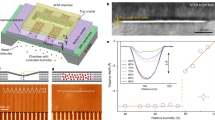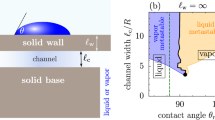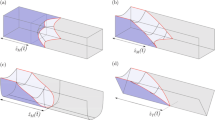Abstract
Banks and Barkas1 have recently directed attention to the mechanical interaction between capillary condensed liquid and the walls of the pores containing it, and they deduce that under certain conditions the pores may collapse when the vapour pressure over the system is lowered. However, when capillary condensation occurs, the liquid condenses on an adsorbed film—not on a bare surface—and it is to be expected that when the vapour pressure is sufficient to cause condensation of liquid, there will always be present an adsorbed film which is mobile. A mobile film exerts a pressure2 numerically equal to the free-energy lowering per unit surface due to its adsorption, and in a capillary tube this pressure opposes the tension of the condensed liquid. Effects due to the pressure of a surface film have been neglected by Banks and Barkas in their calculations.
This is a preview of subscription content, access via your institution
Access options
Subscribe to this journal
Receive 51 print issues and online access
$199.00 per year
only $3.90 per issue
Buy this article
- Purchase on SpringerLink
- Instant access to full article PDF
Prices may be subject to local taxes which are calculated during checkout
Similar content being viewed by others
References
Banks and Barkas, Nature, 158, 341 (1946).
Bangham, Trans. Faraday Soc., 33, 805 (1937).
Author information
Authors and Affiliations
Rights and permissions
About this article
Cite this article
HIRST, W. Dimensional Changes Accompanying Capillary Condensation. Nature 159, 267–268 (1947). https://doi.org/10.1038/159267b0
Issue date:
DOI: https://doi.org/10.1038/159267b0



